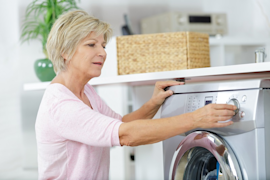LG Wi-Fi front-load washer error codes

These error code explanations can help you diagnose a problem with your LG Wi-Fi enabled front-load washer. Error codes blink on the washer’s digital display when the control detects a problem or part failure. The washer stops and won’t respond until you fix or replace the failed part. When an error code appears on your washer:
Match the error code with the code in the chart below.
Make sure that the condition listed with the error code is the same as the symptom(s) shown by your LG front-load washer.
Read the DIY advice to learn how to troubleshoot the issue and determine the problem part.
Follow repair guide instructions (if listed) to fix the broken part.
For repair how-to help, visit the repair help section, which includes troubleshooting and repair advice for washing machines, other major appliances, lawn and garden equipment, garage door openers, vacuum cleaners and more.
Not filling
Make sure that valves supplying water to the washer are open. If the water valves are open, move the washer forward and unplug the power cord. Shut off the water supply to the faucets and disconnect the water supply hoses from the back of the washer. Check the inlet water valve screens for deposits and replace the valves if you find clogged screens. Don’t clean screens because debris can get into the valve causing a leak and potential flood even when closed. If the screens are clear, place the ends of the water supply hoses in a bucket and briefly open the faucets to see if water flows through the hoses. Check the hoses for clogs if water doesn’t flow through the supply hoses. If water flows through the supply hoses, remove the top cover and check the wire harness connections between the control board and the inlet water valves. Reconnect any loose wires. If the wiring connections are okay, then you’ll likely need to replace the inlet water valves. If the problem continues, you’ll likely need to replace the control board.
Unbalanced load
Make sure the washer is properly leveled. If a small load is in the washer, add a few towels or garments to balance the load. Check the load to see if it's tangled. Heavy items mixed with light ones may not be able to be balanced properly. Adjust the load.
Drains slowly
Check the washer drain for a clog. Check the drain hose for a kink or restriction. Unplug the washer and check the wire harness connection between the electronic control board and the drain pump. Reconnect any loose wires or replace the wire harness if damaged. If the drain pump doesn't run when activated, replace it.
Water overflow error
The drain pump runs constantly when the FE error code is displayed. Check to see if the tub fills with water when the power cord is unplugged. If it does, then an inlet water valve is leaking—replace the inlet water valve assembly.
Water level sensor failure
Unplug the washer and check the wire harness connections between the water level sensor and the electronic control board. Reconnect any loose wires or replace the wire harness if damaged. If the wire connections are okay, replace the water level sensor.
Door is open
Unplug the washer. Check the door for an obstruction. If the door is damaged, replace any defective parts. If the door closes properly, check the door lock/switch assembly wiring. If the wiring connections are okay, then you’ll likely need to replace the door lock/switch assembly.
Thermistor (temperature sensor) failure
Unplug the washer and check the wire harness connection between the thermistor and the electronic control board. Reconnect any loose wires. If the wiring harness connections are okay, replace the thermistor.
Locked drive motor error
If the washer is overloaded, pull some clothes out and restart the cycle. For future loads, fill the basket loosely. If you see lots of suds in the tub, let the washer sit idle for 30 minutes so the foam dissipates. Next, start a Drain/Spin cycle to remove the sudsy water. Then run a new cycle without adding any detergent to wash and rinse the current load. For future loads, reduce the amount of high-efficiency (HE) detergent to about 1 tablespoon per load. If you didn’t overload the washer and you don’t see excessive suds, check the rotation of the spin basket. First, cancel the wash cycle and pull your clothes out of the washer. Drain any water left in the tub by running a Drain/Spin cycle with No Spin selected. If this cycle doesn’t remove the water, unplug the washer and suck out the water through the drain hose using a wet/dry shop vac. After draining the water, unplug the washer again, open the door and manually rotate the spin basket. If the spin basket doesn’t rotate smoothly, there may be an item stuck between the basket and the outer tub. A damaged spin bearing also will prevent the spin basket from spinning freely. Have a service technician complete this repair because it requires taking the washer apart completely. If the spin basket rotates smoothly, a problem with the drive motor or tachometer can cause the LE error code. Loose or broken wires also can prevent the drive motor from rotating, as can broken magnets in the motor rotor. Check for loose motor wire connections and examine the motor rotor magnets. Unplug the washer and remove the top and back washer panels. Remove the rotor-mounting bolt and pull off the motor rotor. Check the magnets on the inside edge of the rotor for damage and replace the rotor if you find broken magnets. Check the wire harness connections between the electronic control board and the drive motor. Reconnect any loose wires or replace the wire harness if it's damaged. Check the wire harness connections between the tachometer and the electronic control board. Reconnect any loose wires or replace the wire harness if it's damaged. If the wire connections and the rotor magnets are okay, then you'll likely need to replace the motor tachometer or drive motor. Have a service technician examine the washer and test the tachometer and motor to accurately determine which parts need replacing.
Electronic control board failure
Try to clear the code by unplugging the washer for 5 minutes. Restore power and see if the code clears. If not, then replace the electronic control board.
Power Failure
A power failure occurred during the cycle. The cycle may not have completed properly. Start a new cycle.
Excessive suds
When excessive suds are detected, the cycle goes into a suds kill routine by filling the tub with water and then tumbling the clothes. If this routine doesn't eliminate the suds, the control displays the Sud code. Let the suds dissipate for several hours then use the Rinse, Drain & Spin cycle to finish the cycle. Use the right amount of high-efficiency (HE) detergent with future loads.
Wi-Fi module connection failure
Unplug the washer and check the wire harness connection between the Wi-Fi module and the electronic control board. Reconnect the wire harness if it’s loose. If the wire harness connection is okay, replace the Wi-Fi module.
Wi-Fi module failure
Unplug the washer and check the wire harness connection between the Wi-Fi module and the electronic control board. Reconnect the wire harness if it’s loose. If the wire harness connection is okay, replace the Wi-Fi module.
Most common symptoms to help you fix your washers
Choose a symptom to see related washer repairs.
Main causes: clogged drain hose, house drain clogged, bad drain pump, water-level pressure switch failure, bad control b…
Main causes: worn agitator dogs, bad clutch, broken motor coupler, shifter assembly failure, broken door lock, suspensio…
Main causes: bad lid switch or door lock, bad timer or electronic control board, wiring failure, bad water inlet valve a…
Main causes: broken lid switch or lid lock, bad pressure switch, broken shifter assembly, faulty control system…
Main causes: unbalanced load, loose spanner nut, worn drive block, broken shock absorber or suspension spring, debris in…
Main causes: no water supply, bad water valves, water-level pressure switch failure, control system failure, bad door lo…
Main causes: lack of electrical power, wiring failure, bad power cord, electronic control board failure, bad user interf…
Main causes: leaky water inlet valve, faulty water-level pressure switch, bad electronic control board…
Main causes: water heater failure, bad water temperature switch, faulty control board, bad water valve, faulty water tem…
Most common repair guides to help fix your washers
Effective articles & videos to help repair your washers
Use the advice and tips in these articles and videos to get the most out of your washer.

Find tips for using your washing machine efficiently to save energy and help reduce utility bills.…

Learn about all the convenient features on our Sears PartsDirect website that make your parts purchases easier.…

Get answers to frequently asked questions about Sears and Sears PartsDirect.…